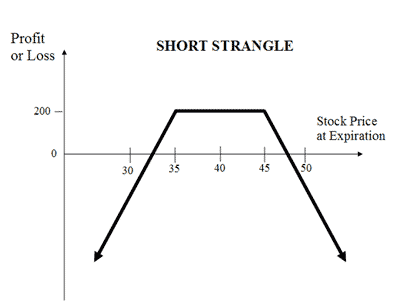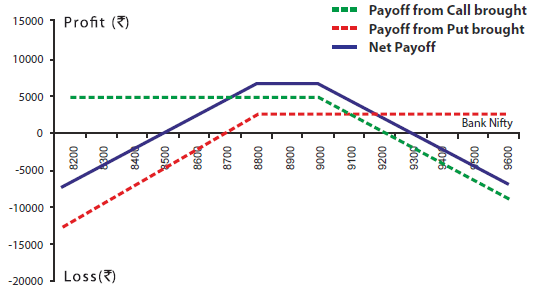 Zerodha (Trading & Demat Account)
Zerodha (Trading & Demat Account)
FREE Equity Delivery and MF
Flat ₹20/trade Intra-day/F&O
 Zerodha (Trading & Demat Account)
Zerodha (Trading & Demat Account)
FREE Equity Delivery and MF
Flat ₹20/trade Intra-day/F&O

|
|
Published on Thursday, April 19, 2018 | Modified on Monday, April 26, 2021

| Strategy Level | Advance |
| Instruments Traded | Call + Put |
| Number of Positions | 2 |
| Market View | Neutral |
| Risk Profile | Unlimited |
| Reward Profile | Limited |
| Breakeven Point | two break-even points |
The Short Strangle (or Sell Strangle) is a neutral strategy wherein a Slightly OTM Call and a Slightly OTM Put Options are sold simultaneously of same underlying asset and expiry date.
This strategy can be used when the trader expects that the underlying stock will experience a very little volatility in the near term.
It is a limited profit and unlimited risk strategy. The maximum profit earn is the net premium received. The maximum loss is achieved when the underlying moves either significantly upwards or downwards at expiration.
A net credit is taken to enter into this strategy. For this reason, the Short Strangles are Credit Spreads.
The usual Short Strangle Strategy looks like as below for NIFTY current index value at 10400 (NIFTY Spot Price):
| Orders | NIFTY Strike Price |
|---|---|
| Sell 1 Slightly OTM Put | NIFTY18APR10200PE |
| Sell 1 Slightly OTM Call | NIFTY18APR10600CE |
Suppose Nifty is currently at 10400 and you expect not much movement in near future. In such a scenario, you can execute short strangle strategy by selling Nifty Put and Call at 10200 and at 10600. The net premium received will be your maximum profit while the loss will depend on how high or low the index moves.
The Short Strangle is perfect in a neutral market scenario when the underlying is expected to be less volatile.
Let's take a simple example of a stock trading at Rs 40 (spot price) in June. The option contracts for this stock are available at the premium of:
Lot size: 100 shares in 1 lot
Net Credit: Rs 100 + Rs 100 = Rs 200
Now let's discuss the possible scenarios:
Scenario 1: Stock price remains unchanged at Rs 40
The total gain of Rs 200 is also the maximum gain in this strategy. This is the amount you received as premium at the time you enter in the trade.
Scenario 2: Stock price goes above Rs 50
Scenario 3: Stock price goes down to Rs 30
| Bank Nifty Spot Price | 8900 |
| Bank Nifty Lot Size | 25 |
| Strike Price(Rs ) | Premium(Rs ) | Total Premium Paid(Rs ) (Premium * lot size 25) | |
|---|---|---|---|
| Sell 1 OTM Call | 9000 | 200 | 5000 |
| Sell 1 OTM Put | 8800 | 100 | 2500 |
| Net Premium (200+100) | 300 | 7500 | |
| Upper Breakeven(Rs ) | Strike price of Call + Net Premium (9000 + 300) | 9300 |
| Lower Breakeven(Rs ) | Strike price of put - Net Premium (8800 - 300) | 8500 |
| Maximum Possible Profit (Rs ) | Net Premium Recieved | 7500 |
| Maximum Possible Loss (Rs ) | Unlimited |
| On Expiry Bank NIFTY closes at | Net Payoff from 1 OTM Call Sold (Rs ) @9000 | Net Payoff from 1 OTM Put Sold (Rs ) @8800 | Net Payoff (Rs ) |
|---|---|---|---|
| 8000 | 5000 | -17500 | -12500 |
| 8300 | 5000 | -10000 | -5000 |
| 8500 | 5000 | -5000 | 0 |
| 9000 | 5000 | 2500 | 7500 |
| 9300 | -2500 | 2500 | 0 |
| 9500 | -7500 | 2500 | -5000 |
| 9800 | -15000 | 2500 | -12500 |

When you are expecting little volatility and movement in the price of the underlying.
Sell 1 out-of-the-money put and sell 1 out-of-the-money call which belongs to same underlying asset and has the same expiry date.
two break-even points
A strangle has two break-even points.
Lower Break-even = Strike Price of Put - Net Premium
Upper Break-even = Strike Price of Call+ Net Premium"
The maximum loss is unlimited in this strategy. You will incur losses when the price of the underlying moves significantly either upwards or downwards at expiration.
Loss = Price of Underlying - Strike Price of Short Call - Net Premium Received
Or
Loss = Strike Price of Short Put - Price of Underlying - Net Premium Received
For maximum profit, the price of the underlying on expiration date must trade between the strike prices of the options. The maximum profit is limited to the net premium received while selling the Options.
Maximum Profit = Net Premium Received
Both Option not exercised
One Option exercised
The strategy offers higher chance of profitability in comparison to Short Straddle due to selling of OTM Options.
Limited reward with high risk exposure.

Add a public comment...

FREE Intraday Trading (Eq, F&O)
Flat ₹20 Per Trade in F&O
|
|